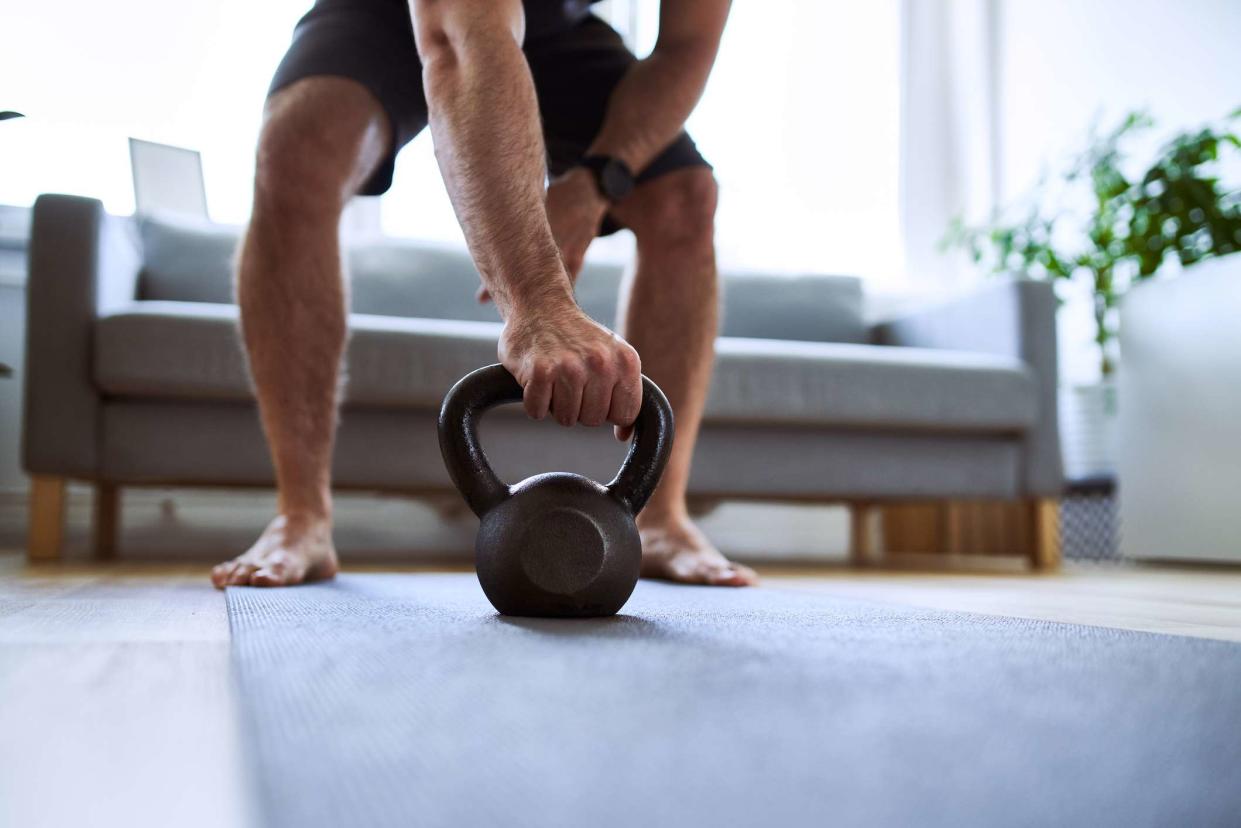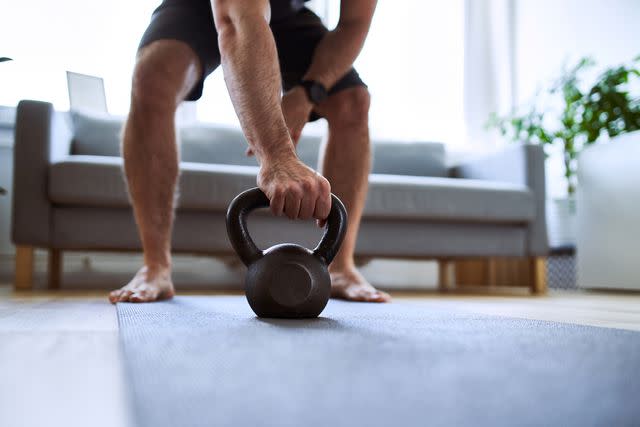Should You Start Working Out Barefoot? Experts Discuss the Pros and Cons

BartekSzewczyk/Getty Images
Fact checked by Nick Blackmer
Working out barefoot has become popular among some gym-goers, and many agree that the practice increases their foot strength, mobility, and balance.
Experts say that these benefits may exist, but there are also some risks associated with working out barefoot, including the possibility of injury or infection.
The safety of barefoot workouts has a lot to do with each individual’s health and lifestyle, but people should start slowly if they want to give it a try.

BartekSzewczyk/Getty Images
Traditionally, a pair of high-quality sneakers has been considered a necessary part of a good workout. But lately many trainers and workout enthusiasts online are encouraging others to try working out barefoot.
Sneakers can offer support, comfort, and stability to help athletes excel at their sport and avoid injuries in the gym. But some say that working out barefoot provides a host of other benefits such as improved mobility and sharper proprioceptive awareness, which is the ability to sense where your body is in your environment.
While it’s true that working out barefoot may come with its perks—mainly, increasing balance and coordination by letting the feet connect directly with the ground—it’s not for every person or for every activity. In certain cases, it can do more harm than good.
“On the plus side, it can help strengthen your feet and increase proprioception,” Gregory Alvarez, DPM, podiatrist at the Ankle and Foot Centers of America, told Health. “On the other hand, there are some risks involved in exercising without shoes.”
Here’s what experts had to say about whether people should consider ditching their sneakers, and the precautions to take to ensure a safe workout.
Evidence for Working Out Barefoot Is Mixed
It’s true that barefoot workouts can have a number of perks, as online creators have suggested. Exercising barefoot can help increase foot strength and proprioception, thereby boosting people’s balance and reducing their risk of getting injured, explained Alvarez.
“The increased sensory feedback from the sole of the foot may lead to better body awareness and coordination and enhanced neuromuscular control,” he said. The reward: improved balance, agility, strength, and stability.
And working out barefoot can be good for the foot itself, too. When people are barefoot, their foot muscles have to work harder because they don’t have the support provided by an athletic shoe, explained Anna Balabanova Shannahan, MD, the associate director of education at the Osher Center for Integrative Medicine at Northwestern Medicine.
“Being barefoot requires you to have more ankle stability and can increase plantar support,” she told Health.
Beyond better balance, strength, and stability, another bonus is that working out barefoot can help a person move about more naturally—movement can get restricted when wearing shoes that are packed with cushioning materials, Alvarez said.
That being said, there are still some risks.
Because the soles of our feet aren’t as tough as athletic footwear, going barefoot can make someone more vulnerable to cuts and scrapes. Plus, when exercising in public—say, a gym or fitness studio—there’s a chance a person could expose their bare feet to a fungal infection such as athlete’s foot, Alvarez added.
In terms of actual athletic performance, there’s been a good amount of research conducted on exercising while barefoot, but the results are pretty mixed.
One small study found that running barefoot for eight weeks didn’t actually have much of an impact on strength and proprioception. Researchers said it was difficult to know if being barefoot wasn’t beneficial, or if it simply takes longer than eight weeks to see results. Another study on deadlifting found that going barefoot didn’t seem to boost performance as compared to lifting with shoes.
However, another report followed young adult women who played netball—a sport similar to basketball—and found that playing barefoot improved their ankle stability and agility.
“Despite some of these benefits, it’s not well known how they then impact overall performance,” said Dr. Shannahan.
Related: Here’s How Your Feet May Change After Walking Barefoot
Is Working Out Barefoot Right for You?
In light of the pros and cons, determining if it’s safe to try out barefoot exercise really depends on an individual’s health and what their preferred activity is.
People who have pre-existing foot conditions such as plantar fasciitis, heel spurs, or bunions, will want to keep their shoes on.
In addition, sneakers may still be a good choice for people with low arches, since shoes provide support to the planar fascia ligament, or the ligament that connects the heel bone to the toes and helps provide support to the arch of the foot. The same goes for those with high arches—sneakers can help maintain that arch, according to Bruce Pinker, DPM, a board-certified podiatrist and foot surgeon with Progressive Foot Care in New York.
“Added arch support is beneficial for many types of activity, whether it is walking, standing, or running,” he told Health.
The specific workout a person chooses also has a large effect on whether working out barefoot is a smart idea.
It’s generally safe with indoor mat activities, such as yoga and pilates, as long as a person doesn’t have pre-existing foot or ankle issues.
It’s not recommended for cycling, however, as people can bruise or cut their feet on the pedals, said Pinker. And if someone likes to work out or go running outside, it’s best that they lace up to avoid injuries from stepping on sharp objects such as debris or uneven surfaces, he added.
“Choosing a safe surface for barefoot activity can be challenging, as even grassy fields can present some risks,” said Pinker.
When strength training at home, people can try taking off their shoes to test out their proprioception—but if someone’s at the gym where bacteria can spread, it may be worth keeping their socks on. Dr. Shannahan still recommends sneakers when doing heavy weight lifting.
“It can be better to wear shoes specifically for this to provide additional support to the foot and ankle to prevent injury,” she said.
If you do decide to workout barefoot, you’ll want to get into it gradually and give your body time to adjust.
“Start with short sessions at low intensity until your feet become more accustomed to the sensation,” Alvarez said.
People can try going barefoot while they warm up and cool down before trying to do the entire workout without shoes, said Dr. Shannahan. Start with slower or shorter runs at first, for example.
Strengthening your legs, hips, and buttocks, along with your foot and ankle, can also make the transition easier. Adding muscle can “[compensate] for the lack of cushion, high heel, and support that your feet may be used to,” Dr. Shannahan said.
There is also minimalist footwear that provides less support than a sneaker and “still allows for more natural biomechanics,” said Pinker.
It’s never a bad idea for people to get evaluated by a podiatrist or specialist at a running store to determine if they may have any issues that would make working out barefoot painful. But the most important thing is that people to listen to their bodies. If working out barefoot feels great, then stick with it—but if it starts to feel painful, stop and take care of yourself.
“Ultimately, everyone’s feet are different,” Alvarez said. “It is important to find what works best for you.”
Related: 14 Foot Pain Causes and How To Ease the Pain
For more Health news, make sure to sign up for our newsletter!
Read the original article on Health.

